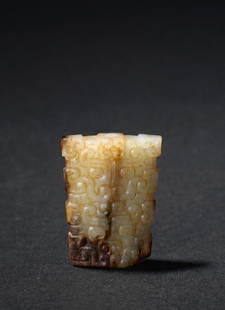
A GROUP OF ELEVEN ARCHAIC JADE ORNAMENTS Neolithic Period to Han Dynasty (11)
Similar Sale History
Recommended Items



Item Details
Description
A GROUP OF ELEVEN ARCHAIC JADE ORNAMENTS
Neolithic Period to Han Dynasty
Comprising: four jade beads of cylindrical form, each centred by an aperture drilled vertically, the stones of reddish brown and celadon with brownish veins; a pair of chicken-bone circular tubes, each of cylindrical form drilled vertically to allow stringing; a jade disc, bi, drilled to the centre with an aperture and incised with a dragon to each side; a smaller plain jade disc, bi, centred with an aperture, the stone of brownish tone with darker veins; a pair of bell-shaped pendants, the knops perforated for suspension; a jade awl-shaped ornament of rectangular shape tapering to a pointed end, surmounted by a knop perforated for suspension; a jade fish carved in an arc with incised fins and a pierced eye; and a jade seal with a square base and trapezoidal top pieced for suspension purpose. The chisel: 8.1cm (3 1/8in) long (11).
Footnotes:
新石器時期至漢 玉勒子、玉璧、玉佩、玉魚、玉方印及錐形玉器 一組十一件
During the Qin and Han dynasties, the style of jade seals was often simple and concise, adopting a inverted funnel shape where the upper part is smaller than the lower part. As seen in the present lot, to save effort and prevent the top from being damaged, the holes of Qin and Han jade seals were always drilled slightly downward from both ends, resulting in an outer-large-inner-small shape. See a similar jade seal, Han dynasty, in the Qing Court Collection, in the National Palace Museum, Taipei (acc.no.故玉000116N000000000). See a related jade rectangular seal, Western Han dynasty, which was sold at Christie's Hong Kong, 29 November 2022, lot 2745.
Archaeological reports suggest that the awl-shaped ornaments were used as hair ornaments for noble males. When the awl-shaped ornaments were unearthed, their pointed ends faced outward. See a group of nine similar awl-shaped ornaments, Neolithic period, Liangzhu culture, illustrated in Liangzhu yuqi 良渚玉器, Beijing, 2018, p.82.
Fish-shaped jade was a predominant jade type from late Shang to early Western Zhou. See five related jade fish pendants, from Shang to Western Zhou period, illustrated by J. Rawson, Chinese Jade: From the Neolithic to the Qing, London, 1995, pp.228-229.
Jade discs of the present originally were employed as ritual implements, and subsequently might have been cherished as antiquities, passed down among collectors throughout dynasties. The dragons on the larger jade bi should be carved later. See a related plain bi, c.2000-1500 BC, illustrated by J. Rawson in Chinese Jade from the Neolithic to the Qing, London, 1995, pp.157-158, pl.7:8.
See a related group of jade ornaments, Neolithic period to Han dynasty, which was sold by Bonhams Hong Kong, 30 May 2017, lot 11.
Neolithic Period to Han Dynasty
Comprising: four jade beads of cylindrical form, each centred by an aperture drilled vertically, the stones of reddish brown and celadon with brownish veins; a pair of chicken-bone circular tubes, each of cylindrical form drilled vertically to allow stringing; a jade disc, bi, drilled to the centre with an aperture and incised with a dragon to each side; a smaller plain jade disc, bi, centred with an aperture, the stone of brownish tone with darker veins; a pair of bell-shaped pendants, the knops perforated for suspension; a jade awl-shaped ornament of rectangular shape tapering to a pointed end, surmounted by a knop perforated for suspension; a jade fish carved in an arc with incised fins and a pierced eye; and a jade seal with a square base and trapezoidal top pieced for suspension purpose. The chisel: 8.1cm (3 1/8in) long (11).
Footnotes:
新石器時期至漢 玉勒子、玉璧、玉佩、玉魚、玉方印及錐形玉器 一組十一件
During the Qin and Han dynasties, the style of jade seals was often simple and concise, adopting a inverted funnel shape where the upper part is smaller than the lower part. As seen in the present lot, to save effort and prevent the top from being damaged, the holes of Qin and Han jade seals were always drilled slightly downward from both ends, resulting in an outer-large-inner-small shape. See a similar jade seal, Han dynasty, in the Qing Court Collection, in the National Palace Museum, Taipei (acc.no.故玉000116N000000000). See a related jade rectangular seal, Western Han dynasty, which was sold at Christie's Hong Kong, 29 November 2022, lot 2745.
Archaeological reports suggest that the awl-shaped ornaments were used as hair ornaments for noble males. When the awl-shaped ornaments were unearthed, their pointed ends faced outward. See a group of nine similar awl-shaped ornaments, Neolithic period, Liangzhu culture, illustrated in Liangzhu yuqi 良渚玉器, Beijing, 2018, p.82.
Fish-shaped jade was a predominant jade type from late Shang to early Western Zhou. See five related jade fish pendants, from Shang to Western Zhou period, illustrated by J. Rawson, Chinese Jade: From the Neolithic to the Qing, London, 1995, pp.228-229.
Jade discs of the present originally were employed as ritual implements, and subsequently might have been cherished as antiquities, passed down among collectors throughout dynasties. The dragons on the larger jade bi should be carved later. See a related plain bi, c.2000-1500 BC, illustrated by J. Rawson in Chinese Jade from the Neolithic to the Qing, London, 1995, pp.157-158, pl.7:8.
See a related group of jade ornaments, Neolithic period to Han dynasty, which was sold by Bonhams Hong Kong, 30 May 2017, lot 11.
Condition
Wear to all of them, many with small or old shallow chips, abraded areas, some with calcified areas.
Buyer's Premium
- 28% up to €40,000.00
- 27% up to €800,000.00
- 21% above €800,000.00
A GROUP OF ELEVEN ARCHAIC JADE ORNAMENTS Neolithic Period to Han Dynasty (11)
Estimate €4,000 - €6,000
4 bidders are watching this item.
Shipping & Pickup Options
Item located in London, England, ukSee Policy for Shipping
Payment

TOP





















































